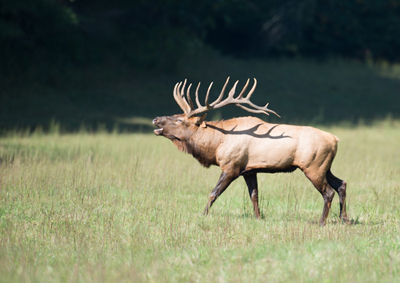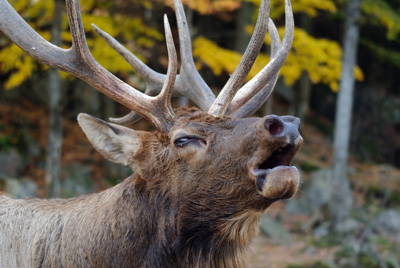
Locating elk can often be a challenge. Here are some of my observations and tips for finding them.
“Is that elk?” I asked my wife to confirm what I was hearing. We were setting up our tent to begin a scouting trip. My first archery elk hunt was 2 weeks away, and I was excited. I was unsure of what I had heard, because some birds can sound much like elk. I heard the sound again, louder, and more than one. “That IS elk!” We paused our camp setup and climbed the nearby hill. When we reached the top, we were overlooking the main forest road. Walking up the road was a herd of cows, calves, and small bulls. We stopped counting after we reached 70. I was pumped! This was going to be an awesome hunt! The next morning we drove and hiked to another area and stumbled on another herd of about 35. The place was crawling with elk!
Fast forward 2 weeks later. On the opening day of the hunt, I went to the areas where I had seen so many elk. Nothing. I expanded my search area, but kept returning to sites where I had seen the large herds. I didn’t even see fresh tracks. The first 3 days of the hunt I didn’t see any elk. None. Where did they go?
When I did begin to catch glimpses of elk, they were no longer in large herds. I began to see small groups with a bull and a few cows. They weren’t in the big open meadows where I spotted them during my scouting trip. They were on the ridge tops and headed for dark timber. I began to see evidence that the bulls had spent the summer in the higher country.
What happened between my scouting trip and my hunting trip? In short, the rut started. The bulls came down from their summer playground and split up the large herds. Each bull worked to gather a harem of cows and move them to an area where he could fend off other suitors. This knowledge allowed me to do a better job of locating elk.
Knowing the reasons that elk relocate and how to respond can make the difference between a successful hunt and a nice hike. Here are a few of the ways I have become better at locating elk.
Rut
Hunting during the rut can be a blessing and a curse. This time of the year can turn the elk’s world upside down. Often bulls will keep their cows on the move, trying to avoid other bulls. Patterning them is sometimes difficult. Rather than snoozing during the daylight hours, the herd may relocate.
The best way to find elk during the rut is to listen for bugles. Bull elk will keep track of each other by bugling at each other. Not only will bulls bugle while the herd is feeding, they will even bugle while bedded. I find that listening for bugles can be the best way for locating elk during the rut. I may bugle with my elk call to try and get bulls started “talking”. This can be a good option for locating elk, but over-calling can cause a bull to go quiet. He may then gather his harem and move. I bugle sparingly and listen carefully.
Hunting Pressure
It’s no secret that hunting pressure may make locating elk difficult. But when I say “Hunting Pressure”, what exactly do I mean? It’s not just gunshots that alert the elk, it’s all human activity.
Since most public hunting lands have access roads, the occasional rancher’s truck or weekend camper’s ATV probably won’t disturb the elk. But when the forest roads begin to look like rush hour traffic, the elk may avoid those areas. As hunters move through the elk woods, making noise and spreading scent that’s not normally there, elk may move out or stay more hidden.
If I have trouble locating elk, I look for areas without roads that other hunters may avoid. Elk know these areas and will move there when hunting pressure is high.
While you can’t control the activity of other hunters, do your best to minimize your impact to the elk environment during the hunt. Do more walking than driving. Do more looking and listening than walking. Bury your biological waste to minimize scent. Speak in low tones to minimize sound. Avoid hunting in the elk bedding areas. This is where they feel the most secure. If disturbed in their bedding area elk may completely leave the area.
Food/Water
In addition to a secure bedding area, elk obviously need food and water. Sometimes the key to locating elk is as simple as locating good feeding grounds and watering locations.
Elk are primarily grazers, and often enjoy feeding on the grass that grows in the large open meadows. But if hunter activity is high, they may only expose themselves in these places in the darkest hours of the night. But elk do browse on many different kinds of plants that grow in the shadows or on the hillsides. Hunting the forested areas between the meadows and the thick bedding areas is often productive. I find that areas recovering from a wildfire in years past can often be a magnet for elk. The fire opens up the canopy, allowing many different plants to sprout, providing a smorgasbord for the elk.
Much of elk country in the west is dry much of the time, and water is obviously mandatory for elk survival. Locating water in these areas is often the key to locating elk. I have killed more than one elk sitting in a makeshift blind on a remote water hole. Water that is far from trees may not be visited by elk until long after shooting light. I look for a water source that is away from heavily traveled roads and has plenty of cover. If there are fresh elk tracks it may be a great spot for an ambush.
Conclusion
There are many reasons that locating elk can be difficult. But if you understand how elk respond to changes in their environment, it will increase your chances of finding them.
Remember to:
- Listen for bugles – Especially during the rut
- Respond to hunting pressure – Hunt away from roads and other hunters
- Minimize your own hunting pressure – Avoid excess human sight, sound, and smell
- Look for areas that meet the basic needs of elk – Food, water, security
Latest posts by Jimmie Norris (see all)
- Elk Hunting Gear Essentials – Radios - April 26, 2020
- Elk Hunting Gear Essentials – Binoculars - February 9, 2020
- Elk Hunting Gear Essentials – GPS - January 19, 2020
- Best Camo Pattern for Elk Hunting - December 1, 2019
- Elk Hunt 2019 Part 2 - November 3, 2019




